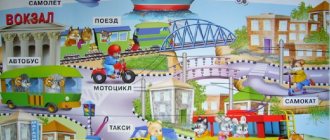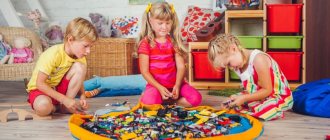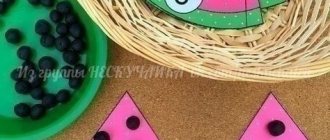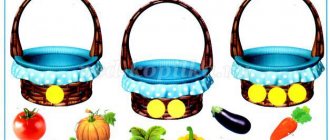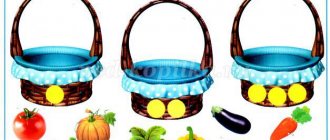The article selected and developed didactic games and exercises for the formation of the morphological structure of speech: for the development and assimilation of inflection and word formation skills (nouns, adjectives and verbs), which allow one to practically master the grammatical categories of the language, expand the child’s passive and active vocabulary. The table matches games to grammatical categories.
The literature on preschool speech therapy has accumulated significant material on the formation of the morphological structure of speech. Based on the methodological recommendations of T.A. Tkachenko, the following approaches were taken into account in the work:
— a clear division of functions between the teacher and the speech therapist (the speech therapist introduces children to the grammatical category, the teacher conducts classes on a special system of lexical topics); — when planning and conducting speech therapy classes, the emphasis is on the grammatical category being studied; — when preparing classes, the task is not to put all the grammatical material into one lexical topic;
During the classes, the vocabulary topic is not indicated, thereby not limiting the active and passive dictionaries, on the basis of which this or that grammatical structure is formed. This made it possible to focus the children’s attention on the morphological form being studied (the endings of nouns, methods of word formation, etc.).
The skills of inflection, word formation and word agreement were formed, attracting children's attention to the morphological composition of the word. During the classes, the child’s attention was recorded in the form of a pronunciation emphasis on the specifically studied morpheme (prefix, suffix), which is the basis of word formation; the ending of words expressing different grammatical meanings (case, number, gender, person), which is the basis of inflection.
In order for each lesson to contribute to noticeable progress in the correction of the morphological structure of speech, a high mental load was created for this purpose. Mental load increases due to exercises for the development of verbal and logical thinking within the framework of the topic being studied, which is ensured by selecting a variety of visual material.
At the initial stage, it is important to teach children to listen attentively to spoken speech, to retain in their memory the material perceived by ear, and to be able to hear mistakes in someone else’s and their own speech. By clarifying the pronunciation and perception of sounds, improving the reproduction of word structure, the children prepared the basis for the development of understanding of speech, the grammatical and morphological system of word formation and inflection. In turn, the development of phonemic perception creates the necessary basis for the formation of the morphological structure of speech.
Play is the main activity of a preschool child, one of the characteristic patterns of child development. Play as a form of child activity contributes to the harmonious development of his mental processes, personal traits, and intellect. A number of studies (A.V. Zaporozhets and others) confirm that the formation of these qualities in a child’s play is realized much faster and more firmly than when using only didactic teaching methods.
| Grammatical category | Didactic games and exercises |
| Topic: Diminutive meaning of nouns | Games: “Big - small”, “Hedgehog hedgehog”, “Call it affectionately” |
| Topic: Nominative case of a noun | Games: “One is many”, “What grows in the forest?”, “Who has a similar picture?”, “Change the word” |
| Topic: 3rd person singular and plural present tense verb | Games: “Guess what the girl is doing and what she is answering?”, “Guess and do the same”, “Change the word”, “Finish the sentence” |
| Topic: Accusative case of singular noun | Games: “Who is the most observant?”, “Correct and tell” |
| Topic: Genitive singular noun | Games: “From which tree did the leaf fall?”, “Erudite” Fairy tale “Kolobok” |
| Topic: Dative case singular and plural of a noun | Games: “Who needs what for work?”, “Guests” |
| Topic: Instrumental singular and plural of a noun | Game: Who defends themselves with what?”, “What do they do?”, “When does this happen?”, “Who is behind whom?” |
| Topic: Prepositional-case constructions | Games: “Caring”, “Help the animals find their home”, “Terrible beast”, “Pooh’s birthday” |
| Topic: Prefixed verbs | Games: “Suggest actions”, “Water game”, “Say the opposite” |
| Topic: Genitive plural of a noun | Games: “Choose a rhyme”, “Preparations for the winter”, Guess what’s missing?” |
| Topic: Relative adjectives | Games: “Winter preparations”, “What is it made of”, “Which leaf?” |
| Topic: Possessive Adjectives | Game “Whose, whose, whose?” |
| Topic: Comparative degree of adjectives | Game "Negotiate proposals" |
| Topic: Formation of complex words Game "Echo" |
Didactic games and exercises for the formation of the morphological structure of speech
Didactic games and exercises on the formation of the nominative plural.
1. Game “One - many”.
Goal: to teach children to form nominative plural nouns.
Visual material: subject pictures – words in singular and plural.
Progress of the game: children were shown a picture depicting one object and were asked to find a picture depicting the same object, but in larger quantities.
Speech material:
— I have a red ball. - And I have red balls (child).
2. Game “What grows in the forest.”
Purpose: formation of the plural form of a noun with the ending -ы.
Visual material: subject pictures and plot picture.
Progress of the game: the plot picture “Forest” was hung on the board, the children looked at the picture, and the experimenter gradually hung cards of singular objects around this picture (oak, pine, birch, mushroom, flower, bush, berry).
Speech material:
— Is there one oak tree growing in the forest? (Oak trees grow in the forest); — Is there only one pine tree growing in the forest? — Is there one mushroom growing in the forest?
3. Game “Who has a similar picture?”
Goal: formation of plural forms of nouns ending in -ya.
Visual material: subject pictures.
Progress of the game: children were given pictures depicting an object in the plural, the experimenter raised his picture and asked the children who had a similar one.
— There is a chair in my picture. Who has the same one?
4. Game "Change the word."
Goal: to consolidate knowledge of the plural form of the nominative case of nouns with different endings.
Equipment: ball.
Progress of the game: the child was named words in the singular and after catching the ball, he must name the word in the plural.
Didactic games and exercises on the formation of the singular genitive case with prepositions.
1. Game “Which tree did the leaf fall from?”
Goal: to consolidate the names of trees, the genitive singular form with the preposition S.
Visual material: subject pictures.
Progress of the game: cards with tree leaves were distributed to the children. Children must determine which tree leaves they have and name the tree: “My leaf fell from a maple tree.”
2. Game "Scrabble".
Purpose: to consolidate the body parts of animals, and the formation of genitive case forms with the preposition U.
Visual material: subject pictures.
Progress of the game: children were given pictures of animals and asked questions.
Speech material:
- Who has a big trunk? - Who has a fluffy tail? -Who has a pointed nose? - Who has long ears? -Who has hooves?
3. We play the fairy tale “Kolobok”.
Purpose: formation of the genitive case form with the preposition from.
Visual material: subject pictures of heroes from the fairy tale “Kolobok”.
Progress of the game: the children were read the fairy tale “Kolobok”, then the fairy tale was read a second time, but with gaps, and the children must continue (from grandmother, from grandfather, from the wolf, from the hare, from the bear).
Didactic games and exercises for the formation of the genitive plural.
1. Didactic game “Choose a rhyme.”
Goal: to develop the ability to form the genitive plural form of nouns.
Visual material: subject pictures.
Progress of the game: a comic poem was read to the children:
I give you my word of honor, Yesterday at half past five I saw two pigs without hats and boots.
“You and I can also make up funny jokes.” I will start, and you continue (the children are shown pictures while reading the poem, which were spoken out in advance).
Speech material:
We give our word of honor: Yesterday at half past five We saw two magpies without ... (boots) and ... (socks), And puppies without ... (slippers), And titmice without ... (mittens).
2. Game exercise “Preparing for the winter.”
Goal: to consolidate the topic “Vegetables and fruits”, to develop the ability to form the plural of the genitive case of nouns.
Visual material: subject pictures.
Progress of the game: the children were told that in the fall, preparations of vegetables and fruits are made for the winter. These are juices, jams, jams, salads, compotes and jams. Afterwards, they were given pictures of vegetables and fruits, and were asked to make suggestions on what they would cook from what was shown in their pictures.
3. Game exercise “Guess what’s missing?”
Goal: to consolidate the ability to form the plural of genitive nouns.
Visual material: subject pictures.
Progress of the game: four pictures with plural objects were hung on the board, then two pictures were removed, and the children were asked: “What is missing?” Pictures were selected with different endings.
Didactic games and exercises for the formation of the dative case singular and plural.
1. Game exercise “Who needs what for work”
Goal: to consolidate the topic “Professions”, to master the dative case in the singular and plural.
Visual material: subject pictures.
a) Progress of the game: children were given pictures showing a teacher without a pointer, a painter without a brush, a hairdresser without scissors, etc. Then each child must stand up, show his picture and say: “I have a teacher without a pointer, he needs to be given a pointer,” etc.
b) Progress of the game: pictures with girls, bears, dogs, etc. were hung on the board, and pictures with objects (book, candy, ball, etc.) were given to the children. Each child must come up with his own picture and choose who he will give what.
Speech material:
- I'll give candy to the girls; - I'll give the book to the bears.
2. Game "Guests".
Goal: consolidation of the topic “Wild Animals”, mastering the dative case.
Visual material: object pictures and soft toys.
Progress of the game: children sat around the table, each child had toys, the experimenter had a bunny, pictures with treats were laid out on the table. Children were asked to choose from a picture for their animal:
- I'll give the nuts to the squirrel; - I'll give honey to the bear.
Didactic games for the formation of the accusative case.
1. Didactic game “Who is the most observant.”
Goal: to develop children's attention, memory, and everyday vocabulary.
Progress of the game: children must look at what is around and name more objects in complete sentences. The first child said in the singular, and the second repeated in the plural.
Speech material:
- I see a table, a window, a chair... - I see tables, windows, chairs...
2. Didactic game “Change and say correctly.”
Goal: to teach children to listen carefully and find mistakes.
Progress of the game: children were asked questions and given answers in the initial form, the child had to give the answer in the correct version.
Speech material:
- Who do I love? What? (mother, Motherland, cat); - Value what? (work, care, friendship); - Take care of what? (book, toy, trees, birds); - Remember what? (fairy tale, song, riddle, poem).
Didactic games to clarify the form of the instrumental case.
1. Didactic game “Who defends themselves with what?”
Goal: to consolidate the topic “Animals and Birds”, mastering the instrumental case.
Visual material: subject pictures.
Progress of the game: children looked at pictures of animals and answered the questions: who is defending themselves with what?
Speech material:
- How does a dog protect itself? (elephant, deer, hedgehog, goose, cat).
2. Game “What are they doing with what?”
Goal: expand your vocabulary, teach how to form phrases and agree a verb with a noun, and learn the instrumental plural form.
Visual material: subject pictures.
Progress of the game: children were given object pictures depicting tools in the plural: saws, axes, shovels, needles, knives, scissors, etc., children had to make up phrases answering the question “What do they saw with (dig, sew, cut and etc.)?
3. Games “When does this happen?”, “Who is after whom?”.
Purpose: to consolidate the form of the instrumental case.
a) Visual material: subject pictures.
Progress of the game: pictures with the seasons were hung randomly on the board, and the children were asked the question “What comes after what?”
b) Progress of the game: children were divided into two teams. The drivers stood in front of the team, with their backs to the other children. Their task is to remember and say who is behind whom. The correct answer is rewarded with a chip.
Games to clarify the form of the prepositional case.
1. Game exercise “Caring”.
Goal: teach children to make sentences based on pictures. Mastering the form of the prepositional case.
Visual material: story pictures.
Progress of the game: children were given pictures depicting children caring for animals and plants. The question was asked: “Who (what) do children care about?”
2. Game exercise “Help the animals find their home.”
Goal: consolidation of knowledge about the home of animals, clarification of the prepositional case.
Visual material: subject pictures.
Progress of the game: pictures with animals' homes were hung on the board, and pictures with animals were hung under the houses in a mixed up form. Children were encouraged to help animals find their home. The answer is given in a complete sentence.
Didactic word formation game “Little Wizards”
"Little Wizards"
This game will help preschoolers become familiar with the method of forming diminutive nouns with the help of “little wizards,” and schoolchildren will develop the ability to identify suffixes in diminutive nouns using game images.
A game for children in the preparatory group for school and for primary classes.
Tasks:
Educational:
Consolidating word formation skills of diminutive words using suffixes.
Formation of the ability to highlight a suffix in a word.
Correctional and developmental:
Development of cognitive interest in words.
Development of auditory attention, phonemic perception.
Development of analytical and synthetic activities, the ability to analyze, compare, synthesize.
Educational task:
Cultivating interest in words and word creation.
Cultivating accuracy when operating playground equipment.
Developing the ability to act in accordance with the rules of the game.
“Little wizards” - suffixes turn large objects into small ones.
Option 1. Introductory
Children are offered pictures that the “little wizard” IK brought. Game “Big - Small” Masculine nouns are offered.
Words: forest - wood, eye - peephole, island - island, ear - spikelet, tooth - clove, city - town
-What two sounds do we hear at the end of a word?
Number of players: 1 or more
Option 2. "Gifts for Little Wizards"
Children select pictures for one or two “little wizards”
Number of players: 1 or more
forest - wood, eye - peephole, island - island, ear - spikelet, tooth - clove, city - town, oak - oak, dove - dove, mushroom - fungus, chalk - chalk, cheese - cheese
coffee-coffee, jelly - jelly, tea - tea, perch - perch, stump - stump, stream - stream, poplar - poplar, anchor - anchor
chair - chair, jug - jug, bell - bell, bud - bud, motor - motor, hare - bunny, finger - finger.
cube - cube, rain - rain, gnome - gnome, tooth - tooth, cat - cat, rhombus - rhombus, magnet - magnet, nose - spout, crane - crane, nose - spout - table - table, house - house, scarf - scarf, garden - garden, nail - nail
A
squirrel - squirrel, button - button, jar - jar, pin - pin, needle - needle, thread - thread, branch - twig, rose - rose, star - star, boat - boat, duck - duck, Christmas tree - Christmas tree, fork - fork, bun - bun,
A
spoon - spoon, cuckoo - cuckoo, ruler - ruler, T-shirt - T-shirt, stove - stove, pillow - pillow, bench - bench, cone - cone
A
water - water, braid - braid, fox - fox, bird - bird, tit - tit
A
winter - winter, willow - willow, swan - swan, grass - grass, owl - owl, rowan - rowan, grandfather - grandfather
Option 3. "Visiting the little wizards"
Equipment:
game cube (with dots or numbers), set of pictures, playing field
Rules:
Cards with pictures are distributed according to the number of children. Children take turns throwing the dice. The number of dots corresponds to the suffix number on the playing field. The child selects a word (picture) with a given suffix and places the card to the left of the “little wizard”. The one who runs out of all the pictures wins.
Number of players: 1 or more people
Internet resource: picture of the forest https://ds04.infourok.ru/uploads/ex/0864/0008323b-38e86593/img8.jpg
xn--j1ahfl.xn--p1ai
Lessons on the formation of changing verbs by person.
Game exercise “Guess what the girl is doing and what she is answering.”
Goal: to teach how to form the 1st and 3rd person forms of verbs.
Visual material: story pictures.
Progress of the game: children were shown plot pictures with a specific image of the action, and answer the questions “What is the girl doing?” and the girl’s answer in the 1st person present tense.
2. Game exercise “Guess and do the same.”
Goal: to teach children to change the 3rd person singular form of verbs to the 1st person singular form of the same verbs.
Progress of the game: one of the children performed an action without an object, the other must guess the action being performed, name it and do the same.
Speech material:
Vova is coming. - I'm going. Katya is sleeping. - I'm sleeping. Tanya drinks. - I drink. Alina is drawing. - I'm drawing. Artem is running. - I am running. Olya is reading. - I am reading.
3. Goal: to teach children to use the same present tense singular verbs in the 1st person plural.
Progress of the task: the experimenter called the action in the singular, and the children must answer in the plural.
Speech material:
I'm coming. - We are going. I sing. - We sing. I wash my hands. - We wash our hands. I walk. - We are walking. I'm playing. - We play. I'm sleeping. - We are sleeping.
4. Game exercise “Complete the sentences.”
Goal: developing skills for matching singular verbs in three persons: 1st, 2nd and 3rd.
Progress of the game: the experimenter began to speak sentences in the 1st person, then addressed the first child, and he answered in the 2nd person, and to the third, he answered in the 3rd person.
Speech material:
I'm coming. - You are walking). - He's coming); I am standing. - You stand). - It costs); I am going for a walk. - You...(go for a walk). - He...(goes for a walk); I'm building a house. - You...(build a house). - He...(builds a house); I'm sleeping. - Are you sleeping). - He's sleeping).
Game exercises and tasks for the formation of an adjective and a noun with a diminutive meaning.
1. Didactic game “Big - small”.
Goal: to teach children to form nouns using diminutive suffixes.
Visual material: subject pictures.
Progress of the game: circles were hung on the board - large and small, and the children were given pictures depicting objects. Each child took turns going to the board, first naming the large object under the large circle, and then the small one under the small one.
2. Game exercise “Hedgehog and Hedgehog”.
Goal: consolidate the topic “Vegetables”, develop education skills, diminutive suffixes.
Visual material: subject pictures, 2 hedgehogs, large and small.
Progress of the game: the children were shown toys: a hedgehog and a hedgehog, and it was explained to the children that they were making supplies for the winter, and they needed to help them. Children have pictures of large and small vegetables. Next, the children distributed the vegetables to the hedgehogs and told what they would give to whom.
Speech material:
- I will give the hedgehog beets (cucumber, cabbage, eggplant, etc.), and the hedgehog some beets (cucumber, cabbage, eggplant).
3. Didactic game “Name it affectionately.”
Goal: to teach children to form adjectives with an affectionate meaning.
Progress of the game: children were asked to name the sign of the object affectionately.
Game exercises and tasks for developing skills in the formation of relative adjectives from the name of a noun.
1. Game “Preparations for the winter.”
Goal: to consolidate the topic “Vegetables and Fruits”, to teach children to form relative adjectives from the name of vegetables.
Visual material: subject pictures.
Progress of the game: the children were given pictures of vegetables, and the experimenter explained that vegetables and fruits can be prepared for the winter, this could be jam, juice, compote, salad. The experimenter asked questions, and the children answered according to their pictures.
Speech material:
— What juice can be made from apples (tangerines, blueberries, pineapple, raspberries, peaches, apricots); — What kind of jam can be made from cherries (lingonberries, apples, currants, pears, plums); — What kind of salad can be made from cabbage (carrots, cucumbers, tomatoes, beets, potatoes, peas).
Similar games were held on the topics “Trees” and “Material”.
Games and exercises to develop skills in the formation of prefixed verbs.
1. Game exercise “Suggest actions.”
Goal: to teach children to form and correctly use the verb GO with different prefixes.
Visual material: toy car.
Progress of the game: the experimenter showed actions with the machine and began sentences, and the children had to continue the sentences and name the action.
Speech material:
- The car left the house (what did it do?) ... (DRIVED AWAY); - The car is on the road...(It went); - The car is approaching the bridge... (DRIVED UP); - The car is on the bridge... (Drived); - The car drove off the bridge... (drove); - The car is a tree...(drove around).
The experimenter repeated verbs pronounced correctly by the children, emphasizing the prefixes with his voice.
2. Game exercise “Playing with water”.
Goal: to teach children to form and correctly use the verb LIT
Visual material: glasses of water, watering can and flowers.
Progress of the game: the experimenter demonstrated the actions and commented on them. Then he repeated these actions and commented on them incorrectly, and the children had to correct the mistakes.
3. Game exercise “Say the opposite.”
Goal: to teach children to name actions with opposite meanings.
Visual material: ball.
Progress of the game: children stand in a circle. The experimenter threw the ball and named the action, and the child who caught the ball named the action with the opposite meaning.
Speech material:
- pours - pours out; - In - Out; - CLOSES - OPENS; - SAILS - SAILS; — COLLECTS – DISASSEMBLES; - Approaches - Drives away.
Game exercises to develop skills in the education of young animals.
1. Game exercise “Terrible beast”.
Goal: to develop the ability to correlate adult animals with the names of their young.
Visual material: subject pictures.
Progress of the game: the experimenter read the story and paused, showing pictures; the children must insert words that are appropriate in meaning.
Speech material:
“The girl Varya had cats with... (kittens), a dog with... (puppies), a duck with... (ducklings), a hen with... (chickens), a goat with... (kids). One day, the ducklings ran to the river, began to swim and dive, and kittens, chickens, puppies and kids looked at them. Suddenly they hear: “Tra-ta-ta!” The kids got scared and ran to their mothers. Kittens to... (cat), puppies to... (dog), ducklings to... (duck), chickens to... (chicken), kids to... (goat).
2. Game exercise “Pooh’s Birthday”.
Goal: to develop the ability to correlate the names of animals with the names of their cubs.
Visual material: toys and object pictures.
Progress of the game: the children stood around the table, pictures with adult animals were laid out on the table. The experimenter told the children about the kitten Pooh and his birthday, how guests came to him and they played hide and seek, and accompanied his story with actions with toys. Children inserted words that suited their meaning and answered questions.
Game exercises to develop skills in forming possessive adjectives.
1. Game exercise “Whose, whose, whose?”
Goal: to develop the ability to form possessive adjectives.
Visual material: object pictures and toys.
Game progress: 1st option. Pictures of animals were hung on the board, and children were given pictures of their individual parts (tail, paw, ears). The children took turns coming to the board and calling out which animal they had a part of.
Option 2. The experimenter showed the children a toy and asked questions: whose?, whose?, whose?
A game exercise to develop skills in forming comparative degrees of adjectives.
1. Game “Negotiate proposals”.
Goal: to teach children to form comparative degrees from adjectives.
Progress of the game: The experimenter read out the sentences, and the children had to finish it.
Speech material:
- Vova is strong, and his brother is even... (stronger); - The car drives fast, but the plane flies even... (faster); — In spring the weather is warm, and in summer it’s even... (warmer); - Lena’s minced meat is long, and Katya’s is even... (longer); - The evening is dark, and the night is still... (darker); - The ice cream is delicious, but the candy is even... (tastier).
Tasks for the formation of two-component words.
Game: "Echo"
Goal: to teach children to form and understand complex words.
Visual material: subject pictures.
Progress of the game: first, a poem was read to the children, each significant part of the word was highlighted with intonation:
A fisherman catches fish. Bees are raised by a beekeeper. A digger is digging the earth. A pedestrian walks on foot. The ice breaks the icebreaker. The leaves are falling - leaf fall is coming. The forest is being cut down by a lumberjack. A chimney sweep cleans the pipes. An all-terrain vehicle is driving along the road. The dust is sucked by a vacuum cleaner.
Afterwards, the poem was read to the children again, but the children themselves finished it.
These exercises and games were given to children as reinforcement material for the kindergarten speech therapist’s main classes on lexical and grammatical topics. We also developed lesson notes on the following topics that were not included in the annual plan (see Appendix):
1. Topic “Professions”.
Goal: to consolidate the concepts and names of professions, to teach children to form the names of professions from actions and objects.
2. Theme "Dishes"
Goal: to consolidate the names of kitchen utensils, to teach how to form complex words from the names of dishes.
3. Topic “Dismissive-increasing suffixes of a noun.”
Goal: to teach children to use and form nouns with disparaging-increasing suffixes.
4. Topic: “Agreement between the adjective and the noun in gender, number and case.”
Many parents are aware of the problem of illiterate writing that has plagued modern domestic schools. They give the child a C for the Russian language according to the principle “three, write two, it’s crazy.” Perhaps the most common mistake in illiterate writing is the inability to choose a test word.
The reasons may be:
- Poor vocabulary and lack of understanding of the meaning of words.
For example, modern children have a poorly developed verbal vocabulary. Most often, some words are replaced by other, more common and similar words. For example, almost always, looking at a picture of a grandmother knitting something, the child confidently states: she is sewing.
Sometimes, realizing that grandma still doesn’t sew, the child comes up with his own word: grandma “knits.”
- Lack of word formation skills.
The most useful thing for preventing illiterate writing is to teach your child word formation. It is impossible to know all the words in your native language. But the skill of consciously forming words is not difficult to learn. And this must be done in preschool age.
It is useful to play the following word games for word formation . There is only one requirement - first we work based on clarity.
Diagrams and drawings help the child use both the right and left hemispheres of the brain and establish a connection between them. This is the most effective option for memorizing and understanding words and expressions in the Russian language.
Word games for word formation of verbs
Word games using dynamic (movement-based) diagrams
Option for non-reading children
Let's draw a story.
This is Vasya. This is the house where he lives.
- Vasya you were leaving the house.
- walked along the sidewalk.
- across the street.
- walked to the stop.
- So was getting off the bus.
- I followed my friend.
- walked towards the school.
- Waugh went to school.
Each oval with an icon shows an action from the story.
Fig.2. Word formation according to Sh. Amonashvili
Children quickly enough (after 10-15 exercises) understand the general way of changing a verb: “Aha! It is necessary to add to the word WALK in front the short particles you-, po-, pere- and others.”
And as soon as they understand, give as many verbs as possible for training.
Option for reading children
If the child can read, then the task becomes easier. For the verb “fly” (the plane took off...), six-year-old Sofia came up with a story and drew such a diagram by the 9th lesson.
Sofia's story on word formation
There was a small plane at the airport. He stood for a long time, but really wanted to fly high, high. One day he flew into the sky. Flew over the forest. Flew over the village. Flew across the river. Flew behind a cloud. And he flew far, far away.
Scheme for the story on word formation
Rice. 3. Word formation: diagrams for readers
Word games for word formation using static diagrams
An example would be the diagram shown in Figure 1. Instead of the verb “to walk” you can put any other verb. It is useful to work with this scheme daily.
Word games for word formation without using diagrams (by ear)
Instructions. Take any two verbs. One will be cheated by an adult, the second by a child, following his example. The adult sequentially adds prefixes to the verb, naming the resulting word. The child adds such a prefix to his word and pronounces the word.
| Drive | Run |
| Move in Move out Move in Move in Move in Move out around Drive in | Run up (up the hill) Run away Run up (wave onto the shore) Run across Run away Run away Run around Run |
Thus, entire families (nests) of cognate words appear, from which it is not difficult to select a test word.
Word games for word formation are the easiest and fastest way to learn verb vocabulary. A preschooler is already capable of mastering word formation. It is only important that he understands the semantic meaning of the words. This is effectively facilitated by coming up with phrases with verbs and showing them in motion.
Please note that in such exercises the child does not just learn to form new words. He learns the general pattern of word formation and can apply it in a new situation without requiring the help of an adult. Language intuition practically develops.
And the last nuance: not all of the verbs formed with the help of prefixes can be used in modern speech. The child’s attention should also be drawn to this.
0
Class notes
Topic: Professions.
Goals: to form concepts and names of professions, to teach how to form the names of professions from actions and objects.
Progress of the lesson
I. Organizational moment.
The experimenter demonstrates toy tools and invites those children to sit down who name what they do with these objects.
II. Main part.
1. Proverbs are read to children:
You can't take a fish out of a pond without difficulty. A small deed is better than a big idleness. After reading the proverbs, the experimenter and the children discuss each proverb.
2. Poems are read to children.
Librarian
This is a home for different books, They have been waiting for you for a long time. Come closer quickly, take a look at the books. There is order here, like in a pharmacy, the shelves are lined up in a row. There is a librarian next to them, He is always happy to see us.
Doctor
If your cheeks are on fire, suddenly stronger than the red calf, If you have a cough, everyone calls a doctor immediately.
Writer
We are all friends with books, Each of us is a reader. And of course, they should know what their writer writes.
Salesman
In the store, at the market And in the buffet, finally, Everywhere we go, We are greeted by a seller.
Shoemaker
With a hammer, knock-knock-knock! All day long, listening to this knock, the shoemaker surprises everyone with the skill of his skillful hands.
After each poem read, the experimenter explains to the children about each profession.
Pictures depicting people and their actions are hung on the board; the experimenter first explains the meaning of professions, then asks each child “Who does what?” not just from pictures.
4. Dynamic pause.
We stomp our feet, we clap our hands, we nod our heads. We raise our hands, We lower our hands, We spin around later.
5. Game “Correct the mistake”
Children are read about incorrect actions in professions that they must correct:
A construction worker flies an airplane, a fireman treats people, a seamstress paints a house, a hairdresser washes clothes, a postman delivers mail, a janitor cooks dinner.
III. Bottom line.
1. Test task, each child must choose the correct answer.
Who keeps order in the library? (policeman, builder, librarian), Who do we call when we get sick? (doctor, teacher, firemen), Who writes books? (musician, writer, shoemaker), Where is the cook while working? (at the TV, at the stove, on the sofa) What does a tailor do? (teaches children, treats people, sews clothes) What does a salesperson do at work? (sleeps, sews, sells) What does the shoemaker repair? (furniture, shoes, clothes), What does a builder do? (builds, flies, teaches), What does the teacher do? (heals, teaches, plays), Where does the teacher teach children? (in a museum, at a zoo, at school).
2. The experimenter lists the names of professions and asks the children to name them in one word - “Professions”.
Topic: Agreement of an adjective with a noun in gender, number and case.
Goals: to teach children to agree adjectives with nouns in gender, number and case; select nouns for adjectives in accordance with gender and number; based on a given generalization, find and correct errors in agreement.
Progress of the lesson
I. Organizational moment.
The experimenter demonstrates the object and invites those children to sit down who can name the signs of this object.
II. Main part.
1. Game “Collect a picture” (using constructive activities)
Children are offered cut-out pictures. It is necessary to collect them and name what they got, highlighting the endings of the words. For example, I have red tomatoes (yellow dresses, blue cups, etc.). Next, the experimenter asks each child how he would say if he had one object. What has changed in the words?
2. Game "Shop"
The experimenter, who is the seller in this game, has various objects and things “on the store counter”. Children as buyers. In order to purchase an object or thing, it is necessary to describe it. For example, please give me a red dress with blue bows; green saucers with yellow flowers, etc. The experimenter focuses the children's attention on the endings they pronounce.
3. Dynamic pause. Game “What object is this?” (with a ball)
Children stand in a semicircle. The experimenter names the sign and throws the ball to each of the children. The child who catches the ball names an object that has this feature and returns the ball. For example, long - rope, skirt, thread; long – train, day, knife, etc.
4. Game “Wildflowers” (using creative activities).
Children are given colored pencils and outline drawings of flowers. Experimenter: “Early in the morning the children went out into the field. They look - the field seems to be covered with a carpet. And the carpet is alive! And all kinds of colors are there: white, blue, red, and yellow! (Children look at the flowers and name them.) The artist painted the flowers that bloomed in that field, but the problem is: he forgot to color them! Let's color them ourselves. What is the name of this flower? (Shows the bell.) What pencil will you use to color it? Why? Etc.
After analysis, the children trace and color the flowers, and then, looking at their drawings, answer the questions: What pencil did they use to color the flowers? Why? The experimenter focuses the children's attention on the endings they pronounce.
5. Game “Find the mistake”
Children are asked to listen to the sentences, find the mistake, correct it, and repeat the sentence correctly.
There is a large book on the table. Masha read a short story. The teacher told an interesting story. A yellow sun is shining in the sky. Anya put on a red dress. There are red apples on the plates. Masha colored the leaves with a green pencil. Etc.
6. Game “What’s missing?”
The experimenter has 6 objects on the table: a blue cube, a green ball, a red ribbon, a gray cat, a yellow bucket, a white saucer. The experimenter first asks to name all the objects. Then the children close their eyes and the experimenter removes one or two objects. Next, the children open their eyes and answer the question: What’s missing from the table?
III. Bottom line
The lesson is summed up and the children’s activities are assessed.
Topic: Dishes.
Goal: consolidate the names of kitchen utensils; teach how to form complex words for the names of dishes.
Progress of the lesson.
I. Organizational moment.
The experimenter demonstrates a piece of utensils and invites those children to sit down who can name its feature.
II. Main part.
1. Pictures of objects depicting dishes are hung on the board, the experimenter talks about each object, what it is for, what they eat and drink from it, and what they eat. Then each item is pronounced together with the children.
2. Game “Set the table.”
A toy set of dishes, toy and real products are laid out on the table. The experimenter, together with the children, places food in dishes and comments on their actions, highlighting word-forming affixes with their voice.
3. Dynamic pause.
Wash the cup, wash the mug - circular movements, alternately with the left and right hands. We put it high to dry - we stretch it up. Oh! A mug fell from the shelf - head tilted left and right. We will collect the fragments - we will sweep the fragments into a dustpan.
4. Game exercise “Cookware Store”.
There are dishes on the table, and each child has a picture of the product. The experimenter explains to the children that each product must be stored in a certain container, and therefore they need to pick up the dishes in the store, but if the item is named incorrectly, the seller will not understand and will not sell the desired item. Each child must choose a piece of utensils for their product with the comment: “I have sugar, and I will buy a sugar bowl,” etc.
5. Game exercise “Donkey visiting a bear cub.”
The children are told that the bear cub invited the donkey to visit, but does not know how to properly arrange the food and needs help. Children must arrange the products correctly and explain their choice: “Sugar should be put in the sugar bowl, sweets in the candy bowl,” etc.
III. Bottom line.
The lesson is summarized. Children's activities are assessed.


